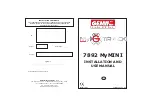
The below definitions have been simplified in order to keep this section brief. We strongly
recommend that anyone who wishes to make use of these measurements refer to one of the
many excellent weather references available for a more in-depth definition. On the internet,
visit
www.usatoday.com
or
www.noaa.gov
. Or, locate the USA Today publication,
The Weather
Book
. Please note that any words in a definition printed in
italics
are themselves defined in this
glossary.
Air Flow:
The volume of air passing through an area for a given period of time. This is commonly
calculated by multiplying the air velocity by the cross sectional area through which the air is
passing.
Dewpoint:
The
temperature
to which air must be cooled in order for condensation to occur. The
difference between
dewpoint
and
temperature
is referred to as the “temperature/dew point
spread”. A small dewpoint spread indicates high
relative humidity
, while a high dewpoint spread
indicates dry conditions.
Heat Index:
A practical measure of how hot the current combination of
relative humidity
and
temperature
feels to a human body. Higher
relative humidity
makes it seem hotter because our
ability to cool ourselves by evaporating perspiration is reduced.
Relative Humidity:
The amount of water vapor actually in the air divided by the maximum
amount of water vapor the air could hold at that
temperature
, expressed as a percentage.
Temperature:
The ambient air temperature.
Wind Chill:
The cooling effect of combined wind and temperature. The wind chill gives a more
accurate reading of how cold it really feels to the human body. The Kestrel 4100’s wind chill is
based on the National Weather Service standards as of November 1, 2001.
14
Store Rate
Total Memory
2 sec
8 min, 20 sec
5 sec
20 min, 50 sec
10 sec
41 min, 40 sec
20 sec
1 hr, 13 min, 20 sec
30 sec
2 hr, 5 min
1 min
4 hr, 10 min
2 min
8 hr, 20 min
5 min
20 hr, 50 min
Store Rate
Total Memory
10 min
1 day, 17 hr, 40 min
20 min
3 days, 11 hr, 20 min
30 min
5 days, 5 hr
1 hr
1 wk, 3 days, 10 hr
2 hr
2 wk, 1 day, 20 hr
5 hr
7 wk, 3 days, 2 hr
12 hr
17 wk, 6 days
Stored data may be uploaded to a PC with the optional Kestrel PC Interface, NK part number 0830.
13
This section provides examples of applications where a Kestrel 4100 might be used, and the appropirate
memory settings.
HVAC - Environmental Monitoring
Auto Store
On
Store Rate
5min
Overwrite
On
Man Store
Off
These settings will record conditions every five minutes, for a total storage of almost 21 hours. You can monitor
the conditions in a laboratory or manufacturing plant, both day and night, to determine if the climate control is
working properly. Or you can examine the effect on the environment when employees enter and exit the
building.
HVAC/R - System Function Verification
Auto Store
Off
Store Rate
—
Overwrite
Off
Man Store
On
These settings will require you to press the Manual Store Button in order to store any data at a duct, hood, vent,
or other system location. The meter will not store any data automatically. Be sure to record the location an date/
time of storage for reference when reviewing the data. After storing the conditions at each location, simply
review the data and balance the system.
Air Duct Measurements
There are two useful techniques for measuring air flow in a duct or at the face of a duct opening. First, the
unit can be used in the Max/Avg Mode(see page 8). Hold the unit in one corner or side of the duct. Press the
button to begin the averaging interval. Slowly traverse the duct. Press the
button at the end of the
traverse of the duct. The maximum and average air flow measurements will be displayed.
Second, the unit can be used to store the air flow at multiple points in a duct. Hold the unit in one position
in or on the duct. Press the
button to manually store the measurements (see page 9). Repeat this process
in multiple positions in or on the duct. When complete, review the stored measurements in the chart data
(see page 7), and average them if desired.
15
16
UNIT
METRIC
IMPERIAL
Velocity
m/s
fpm
Air Flow
m
3
/s
fpm
Temperature Functions
°C
°F
Dimensions
cm
in
Time Format
24 hour
12 hour
Date Format
day/month/year
month/day/year
SETTING
FACTORY DEFAULT
Automatic Data Store
On
Data Store Rate
1 hour
Data Overwrite
On
Manual Data Store
On
User Screen1
velocity, air flow, temperature
User Screen 2
temperature, humidity, dewpoint
User Screen 3
air flow, temperature, humidity
Display Contrast
10
Automatic Shutdown
15 minutes
Language
English























